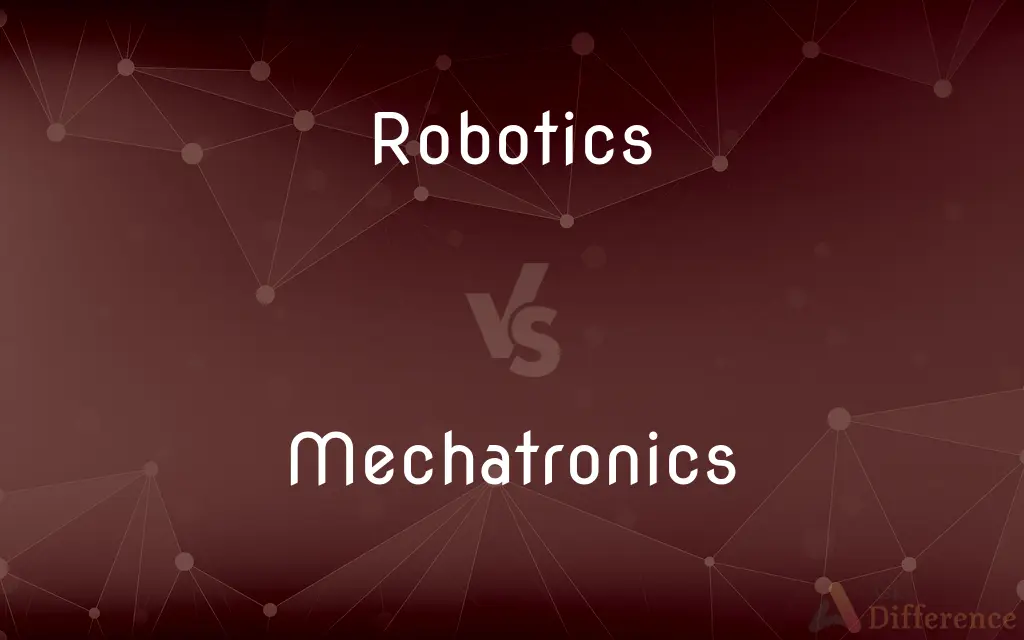Robotics vs. Mechatronics — What's the Difference?
By Tayyaba Rehman & Urooj Arif — Updated on May 13, 2024
Robotics focuses on designing and building robots, emphasizing programming and automation; mechatronics blends mechanical engineering, electronics, and computing to design and create intelligent systems.

Difference Between Robotics and Mechatronics
Table of Contents
ADVERTISEMENT
Key Differences
Robotics is centered around the design, construction, and operation of robots, which are systems that can be programmed to perform tasks autonomously or semi-autonomously. Mechatronics, on the other hand, is an interdisciplinary field that integrates mechanical engineering, electrical engineering, telecommunications engineering, control engineering, and computer science to engineer smart machines and processes.
In robotics, the emphasis is often on the robot's ability to perform tasks that reduce human intervention, such as in manufacturing or hazardous environments. Whereas mechatronics deals with the automation of mechanical processes and creating more efficient and versatile systems, which may not necessarily be considered robots.
The field of robotics often uses the principles of mechatronics; however, robotics specifically focuses on creating robots capable of complex behaviors, including sensing, navigation, and manipulation. Mechatronics, meanwhile, might focus on the optimal design of a single automated system within a production line that does not have to be mobile or adaptive.
Robotics technology is applied in various sectors including healthcare, military, and service industries, aiming to improve efficiency and safety. Mechatronics is critical in sectors like manufacturing and consumer electronics, focusing on improving and innovating product designs and functionality.
Educationally, students of robotics often engage more with computer science and artificial intelligence as part of their curriculum. Mechatronics students, however, delve deeper into systems integration and control theories, which are essential for the development of automated systems.
ADVERTISEMENT
Comparison Chart
Core Disciplines
Computer science, AI, mechanical engineering
Mechanical, electrical, computer engineering
Focus
Autonomous machines
Integrated systems
Applications
Healthcare, military, service industries
Manufacturing, consumer electronics
Educational Curriculum
AI, programming, robot design
Systems integration, control theories
Goal
Enhance task efficiency, reduce human risk
Improve product functionality, innovation
Compare with Definitions
Robotics
The branch of technology that deals with the design, construction, operation, and application of robots.
Robotics is advancing rapidly, incorporating AI to create more autonomous systems.
Mechatronics
The technology combining electronics and mechanical engineering.
Modern mechatronics is used to develop more interactive and adaptive car safety systems.
Robotics
A field of engineering that encompasses the creation of robots and their systems.
She studied robotics to develop new automation solutions for healthcare.
Mechatronics
A synergistic combination of precision engineering, electronic control, and systems thinking in the design of products and manufacturing processes.
Mechatronics engineers work on the seamless integration of sensors in smart devices.
Robotics
The study or use of robot technology.
Robotics competitions encourage students to apply their knowledge in challenging environments.
Mechatronics
The application of complex decision-making to the operation of physical systems.
Mechatronics enables the creation of more efficient automated factory lines.
Robotics
The use of computer-controlled robots to perform manual tasks, especially on assembly lines.
Robotics has revolutionized the automotive industry, streamlining production lines.
Mechatronics
An interdisciplinary branch of engineering that focuses on the engineering of both electrical and mechanical systems.
Mechatronics is integral in the design of intelligent consumer appliances.
Robotics
The scientific study of robots.
Robotics research often overlaps with fields like AI and machine learning.
Mechatronics
The use of control systems and information technologies as integral elements of product design.
Mechatronics has led to innovations in robotics and other areas by enhancing the interface between hardware and software.
Robotics
Robotics is an interdisciplinary field that integrates computer science and engineering. Robotics involves design, construction, operation, and use of robots.
Mechatronics
Mechatronics, also called mechatronics engineering, is an interdisciplinary branch of engineering that focuses on the integration of mechanical, electronic and electrical engineering systems, and also includes a combination of robotics, electronics, computer science, telecommunications, systems, control, and product engineering. As technology advances over time, various subfields of engineering have succeeded in both adapting and multiplying.
Robotics
The science or study of the technology associated with the design, fabrication, theory, and application of robots.
Mechatronics
The synergistic combination of mechanical engineering, electronic engineering and software engineering for the study of automata from an engineering perspective and the control of advanced hybrid systems.
Robotics
The science and technology of robots, their design, manufacture, and application
Robotics
The area of AI concerned with the practical use of robots
Common Curiosities
How does mechatronics differ from robotics?
Mechatronics is broader, involving the integration of mechanical, electrical, and computing systems to create intelligent processes and machines, not limited to robots.
Can mechatronics be considered a part of robotics?
Yes, mechatronics can be considered a foundational element in robotics, providing the necessary systems and controls for robots.
What are typical applications of mechatronics?
Common applications are in product design enhancements, smart manufacturing processes, and consumer electronics.
How do educational paths differ for robotics and mechatronics?
Robotics education often focuses more on programming and AI, while mechatronics emphasizes control systems and hardware integration.
What are typical applications of robotics?
Typical applications include automation in manufacturing, medical procedures, and unmanned vehicles.
What is a common misconception about mechatronics?
It's often mistakenly thought to be solely about mechanical and electrical engineering, without the computing aspect.
Are robotics and mechatronics interdependent?
Yes, the two fields often overlap and complement each other in complex systems and product development.
How do robotics and mechatronics impact industry?
Robotics enhances automation and efficiency, particularly in risky or repetitive tasks; mechatronics improves product functionality and innovation.
What is the main focus of robotics?
Robotics primarily focuses on creating and programming robots to perform tasks autonomously.
What skills are essential for robotics engineers?
Skills in AI, programming, and mechanical design are crucial for robotics engineers.
What is a common misconception about robotics?
A common misconception is that robotics only involves building humanoid robots.
What skills are important for mechatronics engineers?
Mechatronics engineers need strong skills in systems integration, electronic control, and mechanical design.
Can mechatronics lead to better robotics?
Yes, advancements in mechatronics directly contribute to the sophistication and capability of robotic systems.
What is the future of robotics and mechatronics?
Both fields are expanding with technological advancements, playing key roles in the future of automated and intelligent systems.
Can robotics exist without mechatronics?
While theoretically possible, practically, modern robotics relies heavily on mechatronic systems.
Share Your Discovery

Previous Comparison
Contrary vs. Contrast
Next Comparison
Simple vs. SimplyAuthor Spotlight
Written by
Tayyaba RehmanTayyaba Rehman is a distinguished writer, currently serving as a primary contributor to askdifference.com. As a researcher in semantics and etymology, Tayyaba's passion for the complexity of languages and their distinctions has found a perfect home on the platform. Tayyaba delves into the intricacies of language, distinguishing between commonly confused words and phrases, thereby providing clarity for readers worldwide.
Co-written by
Urooj ArifUrooj is a skilled content writer at Ask Difference, known for her exceptional ability to simplify complex topics into engaging and informative content. With a passion for research and a flair for clear, concise writing, she consistently delivers articles that resonate with our diverse audience.
















































